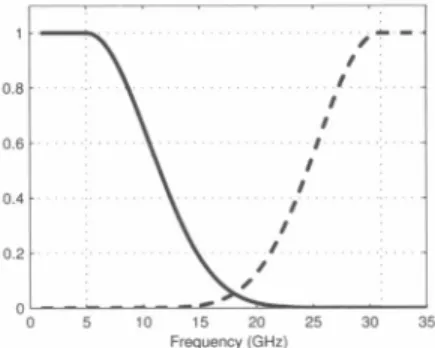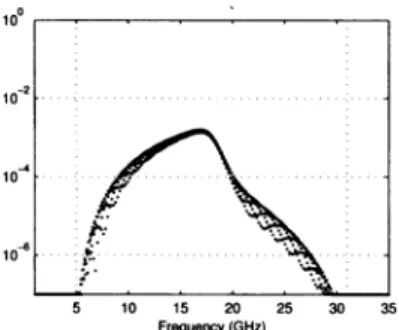Coupled Deconvolution for Frequency Extrapolation of Electromagnetic
Solutions
withMatrix
Pencil Method tLeventGurel* and Ferhat Yildinm
Department ofElectrical andElectronics Engineering Bilkent University, TR-06800, Bilkent, Ankara, Turkey E-mail:lgurel@ee.bilkent.edu.tr,ferhat@ee.bilkent.edu.tr
Abstract
Matrix pencil method (MPM) has been widely used to estimate the parameters of complex-exponential based models. An importantapplication is theextrapolation ofthe frequency-domain solutionsofelectromagneticproblems.Inthispaper, we present a mathe-matical tool,namely, coupled deconvolution, which improves theperformance of the MPM-basedextrapolationof electromagnetic solutions.
I. INTRODUCTION
Solutions of large geometriesathigh frequencieshavealwaysbeen of interest incomputational electromagnetics.Accurate solutions of theseproblemsdemand morememory and CPU time asthe solutionfrequency increases. For very highfrequencies, computationally inexpensive high-frequency prediction techniques can be used to obtain satisfactory solutions. Usually, accuratesolution intervalsof thesetwoclasses ofcomputationalsolversdo not coincide. Inthis work,weproposeusing frequencyextrapolationtoestimate the solution for theintermediate frequency band.
Various numerical approaches have been developed to increase the solution efficiency of thefrequency-domain electromagnetic solvers. Fast methods, suchasfastmultipole method (FMM) and multi-levelfast multipole algorithm (MLFMA), and complex solution strategies, suchas parallel computing, have helped tremendously to push the frequency limits higher; nevertheless, the limits exist. High-frequency solution techniques, suchasphysical optics (PO), basedonthehigh-frequency approximations of electromagnetics, giveaccuratesolutions for relativelyhigh-frequencies but the accuracy decreasesasthe solutionfrequency decreases. In this work, we use model-based extrapolation approach to estimate the solution data in theintermediate frequency band. This isperformed by first constructingasignal modelfrom theknown partof thesignal. This model, which isanapproximation tothe known signal, is assumed tobevalid also for the unknown part of thesignal. Extrapolation is performed by evaluating the constructed model for the frequencies in the unknown part of the signal. To constructthis model, duetoits noise toleranceandcomputational efficiency, we use the matrixpencilmethod(MPM) [1].
Whenperformingtheextrapolation,wehave twoalternatives to findtheestimatedscattering solution for the intermediatefrequencies. Inthe forward case, wemodeltheavailable low-frequency data and perform the extrapolation in the increasing frequency direction. In the tThiswork was supported by theTurkish Academyof Sciences in the framework of the Young Scientist Award Program(LG/TUBA-GEBIP/2002-1-12), by the Scientific and Technical Research Council of Turkey (TUBITAK) under ResearchGrant103E008,andbycontractsfrom ASELSAN and SSM.
0-7803-8883-6/05/$20.00©2005IEEE
backward case, the available high-frequency data is modelled and extrapolation is performed in thedecreasing frequency direction.
II. COUPLEDDECONVOLUTION INMPM EXTRAPOLATION
In the forward and backward MPM extrapolation, as will be presented in the nextsection, theerror levels compared to the reference data are low in the beginning of the extrapolation region.However, theerror tends to increase as we go further in frequency in the extrapolation direction. This behavior is observed for both forward and backwardcases.Inthis work,we propose using coupleddeconvolution tocombine these two separate extrapolation cases, which willgive us a single extrapolation signal with lower error levels. Deconvolution is simply defined as undoing what convolution does. It is a well known property that the convolution operation in the time domain corresponds to multiplication in the Fourier domain [2]. In discretedomain, this relation can be represented as
c[n]=DFT-1{DFT{x
[n]}
* DFT{y[n]}},
(1) where DFTstands for N-point discrete fourier transform. c[n] in(1) can also be calculated intime domain byN-1
c
[n]=
x[(m)N] y [(n-m)NI. (2)m=O
Equation (2) defines an N-point circular convolution, where
(O)N
defines a circular shift in alengthNsequence. With this setof signals, finding x from known c and y is a circular deconvolutionproblem. If werewrite (2) in matrix notation,[Y] [x]
=[El
(3)
we candefine thecircular deconvolution problem as
[x]
=[Yf'i
[Ei
(4)
where [Y]is NxNcircular convolution matrix that contains the valuesof y.
Supposethecomplete solutionsignalofanelectromagnetic problemis Y. Fromlow-frequency solvers we obtain the(0,fL)interval andfromhigh-frequencysolvers we obtain the(fH,
fmna)
interval. Byusing forward MPM extrapolation, we can estimate(fL,fn,,.x)
interval andby using backward MPMextrapolation,we canestimate(0, fH)interval. We define thecoupling region as (fL,fH) and combine thetwoextrapolation results to achieve a lower error level. Wefirst define two windowfunctions in the solution domain: WL, which has nonzero values in the interval(0,fH),
andWH, which has nonzero values in the interval(fL,
f,m).
Fig.1 shows twoChebyshev windows that are constructed inthis manner. Forward MPMextrapolation is performeduptofHtoobtainXL;backward MPMextrapolationsolution isperformeddown to fL to obtain XH. Byusing these four knownsignals, wecan write twoequations that contain the unknownsignal Y asWL Y
=XL,
(5)WH Y
=XH
(6)
Intimedomain, we can rewrite(5)and(6)inmatrix formas
[WLI
[Y1
=[ILI,
(7)[WHI [Y]
=[XH],
(8)
where
[WLI
and[WH]
are the circular convolution matrices of[WLI
and[WHI,
respectively. Ifwecombine (7) and (8) intosingle matrix equation, then[
WH]
] [ HI
(Equation (9) isatotal least-squaresproblem, whose solution willapproximate the time-domain counterpartofthesolutionsignalY of theelectromagnetic problem.Variousapproachescan be used to solve(9), such as singularvaluedecomposition or pseudoinverse [3].
1
-__
0.8 \ 0.6 0.4 02 o s 1015
2025
30 35 Freqwncy(GHz)Fig.1. Chebyshev windows used in coupled deconvolution.
III. NUMERICAL EXAMPLE
Inorder todemonstratetheimprovement inducedby thecoupleddeconvolutionon the MPM extrapolation,wewill presenttheproblemofscattering from a conducting sphere. Backscat-tering of theconducting sphere under plane-wave illumination has analytical solution, hence we canquantitativelydetermine the improvement on the accuracy of the extrapolation supplied by thecoupleddeconvolution. .
Using the analyticalMie-series solution,we obtain the backscattering solution of a conducting spherewith a 30 cm radius between 1-35 GHz. First, 1-5 GHz band of this data is assumed tobeavailable as if it is obtained from a numerical solver. At 5 GHz, numerical solution of this problem requiresa solution of100,000 unknowns, which makes this bandwidth choice reasonable. MPM model is constructed using this 4 GHz band of data and forward MPM extrapolation is performed upto 35 GHz. Fig 2(a) shows the performance of the forward extrapolationintermsoftheerrorbetween theextrapolated signalandtheanalyticalsolution. Next, 31-35 GHz band of thebackscattering data is assumed to be available through a high-frequency approximation technique. This band of data is used to construct the MPM model andbackward MPM extrapolation is performed down to I GHz. Fig 2(b) shows the error of thebackward extrapolation.
Finally, by using thewindows shownin Fig. 1, thesetwoextrapolation results are coupled. Fig. 3showstheerroroftheextrapolation aftercoupled deconvolution is applied to forward andbackward MPM extrapolation results. Considering Figs. 2(a) and 2(b) together, it can be seen that theextrapolation errors for both cases grow as the extrapolation marches away from
the available data. WhentheseresultsarecomparedwithFig. 3, applicationof thecoupled
deconvolution clearlyimprovestheerrorperformance.
100 5 10 15 20 25 30 35 Frequency (GHz) (a)
Ws
~~~~~~~.
5 10 15 20 25 30 35 Frequency(GHz) (b)Fig. 2. Error of (a)forward MPM extrapolation; (b) backward MPM extrapolation. 1oo
102
10
5 10 15 20 25 30 35
Frequency (GHz)
Fig. 3. Error isreduced whencoupled deconvolutionisusedtocombine theforwardand backwardextrapolation schemes.
IV. CONCLUSION
Inthispaper,wepresentamathematical tool,namely, coupled deconvolution,tobe used in conjunctionwiththe MPMextrapolation method for thefrequencyextrapolation of electromag-neticsolutions.Using thelow-frequencyandhigh-frequencysolutions ofanelectromagnetic
problem,we can successfullyestimate the solution in the intermediatefrequencyband.
REFERENCES
[1] F. Yildmmand L.Gurel, "Coupledmatrixpencilmethod forfrequency extrapolationofelectromagnetic solutions,"200SIEEEAP-S InternationalSymposium, Washington, DC, July2005.
[2] AlanV.Oppenheim,Ronald W. Schafer and John R.Buck,Discrete-TimeSignalProcessing. UpperSaddle River,NJ: PrenticeHall, Inc.,1999.
[3] GeneH.GolubandCharlesF.VanLoan,MatrixComputations.Baltimore,MD:JohnsHopkinsUniversity Press,1989. 159 100 lo-2 10 10

